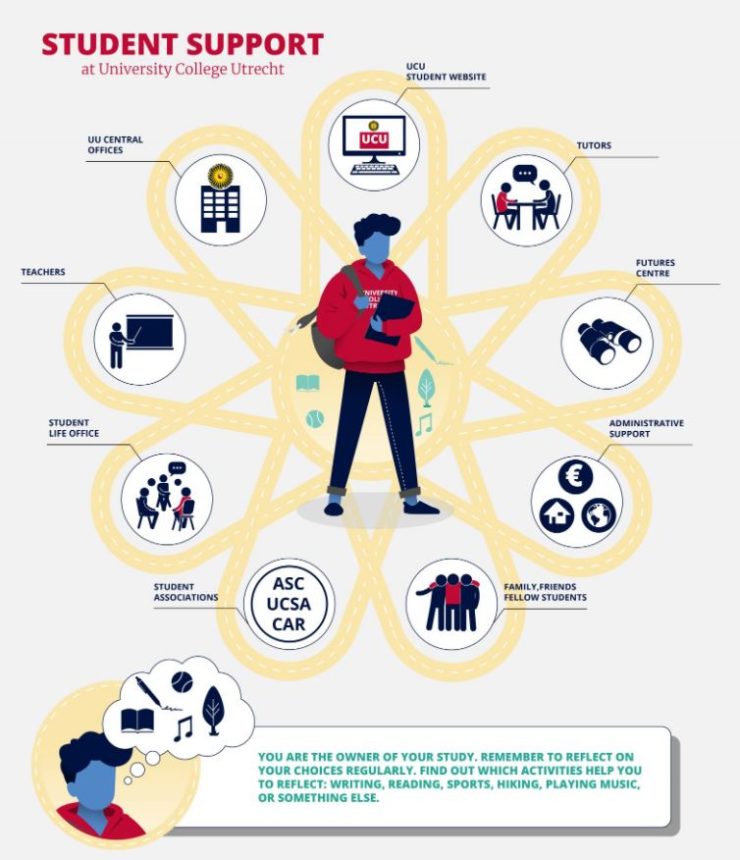Blog
UCU’s student agency project
Finishing an educational innovation project
The past two years, I had the opportunity to lead an education innovation project as senior Comenius fellow. The project aimed to create an environment for the University College Utrecht (UCU) students to easily find their way in the complex curriculum of UCU. A mission I took on as Director of Education for UCU. At UCU students create their own curriculum, the broader the better. Anything goes, as long as it adheres to the graduation requirements. Semesterly student choices for the upcoming courses are important decision-making moments. In such an environment, you want to enable the students to get the best out of their learning. How to facilitate this?
One answer is encouragement of self-reflection. With self-reflection, we mean being aware of your own values and competencies, and using this to make curriculum choices to design your own personal path towards graduation and beyond. This reflection can be encouraged by personal goal setting. What are my short and long term goals? What steps do I need to take to reach those? Reflection and goal setting are necessary at different points in time throughout the students journey. Because through self-reflection you may find out that your goals are changing. The UCU tutors are the academic advisors for the students. Their role is to guide the student and to help the in reflection, setting goals and making decision. Also peer advice is an important information source to feed into the reflection.
Over the years, UCU grew with more and more courses and options. Students found it difficult to get an overview of the options and restrictions in the UCU curriculum. They seemed to pick up the habit to use their tutor as helpdesk in the increasingly complex procedural maze called curriculum planning. The tutors therefore were more busy in guiding the students logistically through the rules, regulations and systems instead of the academic guidance for decision making on the basis of personal goals. Our project aim was therefore to make more space for reflection and personal goal setting by unraveling the complex processes and procedures.
During the project, we adjusted the following:
- The UCU student website was updated with a landing page for guiding and support regarding the curriculum;
- A pilot was run to implement MS Teams as communication tool between tutors and tutees (started before the massive implementation since the corona crisis);
- The UU CoursePlanner was adjusted, competencies per course were added and visualized for students.
This was an ambitious project, run during changing circumstances like the corona crisis and a local reorganization and curriculum reform. While our project deadline is approaching, the implementation of the changes at UCU has just begun. Since part of the changes and implications could also be applicable to other programs, I would like to share our results with the TAUU community with this and subsequent blogs.
Part 1 Guiding and support of students
During the course of this project, the student website was revised and a clear lay-out was created. A new page ‘Organise your studies’ now serves as landing page for a general overview of the student guidance and support. An infographic was developed with an overview of all available support, and a short description per item, which directly refers to the specific part on the website. By implementing this landing page as the go-to page from the start of the students’ UCU journey, it should become easier for students to find the necessary information.

Did it become easier for students?
We evaluated the new website during focus sessions with students and tutors. Students appreciate the infographic on ‘Organise your studies’ as a starting point for new students to get familiar with support structures at UCU and to help you find your own learning path. But we had to conclude that the information for students on how to be in charge of their curriculum, is not used optimally yet. A start is made with these changes, but this does not automatically change the way students approach their studies.
In the sessions, the following tips were mentioned to enable the tutor system to move back to one of academic guidance: the need to have more powerful online tools to guide students in their UCU experience. This can make them less reliant on the tutor and help the tutor in their academic guidance role. Also the need for one communication platform was mentioned as suggestion. Both these points are actually part of this project, indicating that with the recent implementations, we are well on our way in adhering to this need, and a thorough and sustainable implementation is necessary.
What about student choices and reflection?
In order for students to be able to get the best out of their learning, the semesterly student choices are important decision-making moments. The way it is organised now, students who want to actively reflect and set their own goals find ways to do so, while others still just do what they need to do, and mainly listen to their peer group for advice on what courses to follow. Do not take me wrong, I see peers as very important partners in reflection, but reflecting with peers is not the same as registering for a course just because a peer told you it is a good course. Students indicate to approach reflection rather technically: you need to fill out the reflection forms and have midterm meetings with your tutors. The magic could – and often does – happen in these meetings. But the downside of the midterm meetings is that they are planned during the busiest time of the semester, when the students are more worried about the exams of the current semester then about planning the next semester or the rest of their lives. Proper reflection takes time, and time is something students at UCU do not have. On the other hand, the students will find a way to create time when the purpose is clear and appealing enough. Therefore – again – creating facilitating circumstances, as we did in this project, is not enough to change standing practice.
How to proceed?
From this part of the project, we conclude that the first step is made: the systems are in place. The next step is needed: implementation. A change in the current practice is necessary for the end goals of the project to be reached. This gap between a project and daily practice is not new, and I think people will recognise this. However, if we look at the educational innovation project as step one, and implementation and change of practice as step two, we will end up where we want to go, it just takes time!
Blog 2: In the next blog on this project I will go into the use of MS Teams, which started as a pilot within this project, until CoVID-19 turned it into a campus wide experiment
 30 oktober 2020
30 oktober 2020
U moet ingelogd zijn om te reageren, gebruik het formulier aan de linkerkant om in te loggen met uw solis gegevens.


